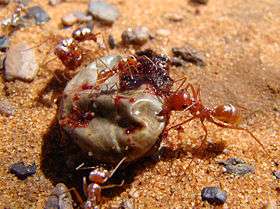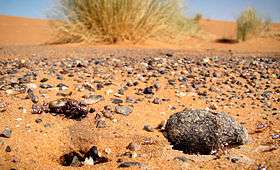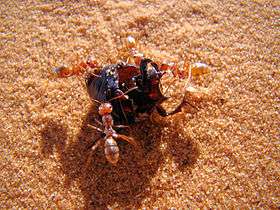Saharan silver ant
| Saharan silver ant | |
|---|---|
 | |
| Scientific classification | |
| Kingdom: | Animalia |
| Phylum: | Arthropoda |
| Class: | Insecta |
| Order: | Hymenoptera |
| Suborder: | Apocrita |
| Superfamily: | Vespoidea |
| Family: | Formicidae |
| Genus: | Cataglyphis |
| Species: | C. bombycina |
| Binomial name | |
| Cataglyphis bombycina Roger, 1859 | |
The Saharan silver ant (Cataglyphis bombycina) is a type of ant that lives in the Sahara Desert.
Largely due to the extreme high temperatures of their habitat, but also due to the threat of predators, the ants are active outside their nest for only about ten minutes per day.[1] The twin pressures of predation and temperature restrict the above-ground activity to a narrow temperature band between that at which the predatory lizard ceases activity and the ant's own upper threshold.[2]

The ants often traverse midday temperatures around 47 degrees Celsius (117 degrees Fahrenheit) to scavenge corpses of heat-stricken animals.[3] To cope with such high temperatures, the ant has several unique adaptations.
They have longer legs than other ants. This keeps their body away from the hot sand,[2] and when traveling at full speed, they use only four of their six legs. This quadrupedal gait is achieved by raising the front pair of legs.[4]
Keeping track of the position of the sun, the ants are able to navigate, always knowing the direct route back to their nest, and thus can minimize their time spent in the heat.[5] They produce heat shock proteins, but unlike other animals they do this not in direct response to heat. Instead they do this before leaving the nest, because they simply are not out in the heat long enough for the proteins to take effect. This protein allows cellular functions to continue even at very high body temperatures. If they did not produce the proteins in anticipation of the extreme heat, they would die before the protein could have its effect.
A few scouts keep watch and alert the colony when ant lizards take shelter in their burrows. Then the whole colony, hundreds of ants, leave to search for food, although they need to complete their work before the temperature reaches 53 degrees Celsius (127 degrees Fahrenheit), a temperature capable of killing them.

In the words of one researcher, the production of this protein "does not reflect an acute response to cellular injury or protein denaturation, but appears to be an adaptive response allowing the organism to perform work at elevated temperatures during temperature changes too abrupt to give the animal an opportunity to benefit from de novo HSP synthesis,"[6] further "the few minutes duration of the foraging frenzy is too short for synthesis of these protective proteins after exposure to heat."[2] This and other adaptations led to the ant being be called "one of the most heat-resistant animals known."[6] Its critical thermal maximum is 53.6 °C (128.5 °F).[7]
Using electron microscopy and ion beam milling, Yu's group discovered that the ants are covered on the top and sides of their bodies with a coating of uniquely shaped hairs with triangular cross-sections that keep them cool in two ways. These hairs are highly reflective under the visible and near-infrared light, i.e., in the region of maximal solar radiation (the ants run at a speed of up to 0.7 metres per second (2.3 feet per second) and look like droplets of mercury on the desert surface). The hairs are also highly emissive in the mid-infrared portion of the electromagnetic spectrum, where they serve as an antireflection layer that enhances the ants' ability to offload excess heat via thermal radiation, which is emitted from the hot body of the ants to the cold sky. This passive cooling effect works under the full sun whenever the insects are exposed to the clear sky.[8]
Notes
- ↑ Wehner, R.; Marsh, A. C.; Wehner, S. (1992). "Desert ants on a thermal tightrope". Nature. Nature Publishing Group. 357 (6379): 586–7. doi:10.1038/357586a0. Retrieved 14 March 2014.
- 1 2 3 Gullan, P. J.; Cranston, P. S. (2004-09-13). The Insects: An Outline of Entomology. Wiley. ISBN 9781405111133.
- ↑ Yoon, Carol Kaesuk (1992-06-30). "Life at the Extremes: Ants Defy Desert Heat". The New York Times. ISSN 0362-4331. Retrieved 2016-01-14.
- ↑ Zollikofer, C (1994). "Stepping Patterns in Ants - Influence of Body Morphology" (PDF). Journal of Experimental Biology. 192 (1): 107–118. Retrieved 2016-01-14.
- ↑ The Amazing Cataglyphis Ant, 2006-02-26, retrieved 2016-01-14
- 1 2 Moseley, Pope L. (1997-11-01). "Heat shock proteins and heat adaptation of the whole organism". Journal of Applied Physiology. 83 (5): 1413–1417. ISSN 8750-7587. PMID 9375300.
- ↑ Chown, Steven L.; Nicolson, Sue W. (2004-07-15). Insect Physiological Ecology: Mechanisms and Patterns. OUP Oxford. ISBN 9780198515487.
- ↑ "Saharan silver ants can control electromagnetic waves over extremely broad spectrum range". m.phys.org. Retrieved 2016-01-14.